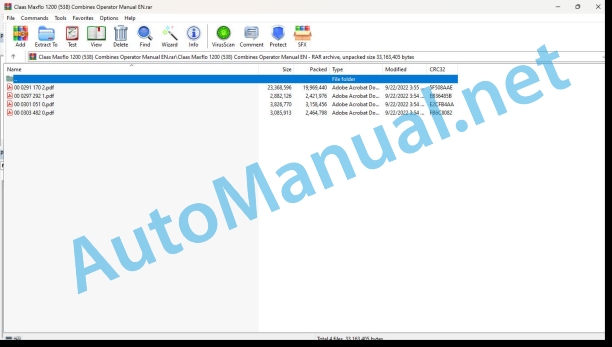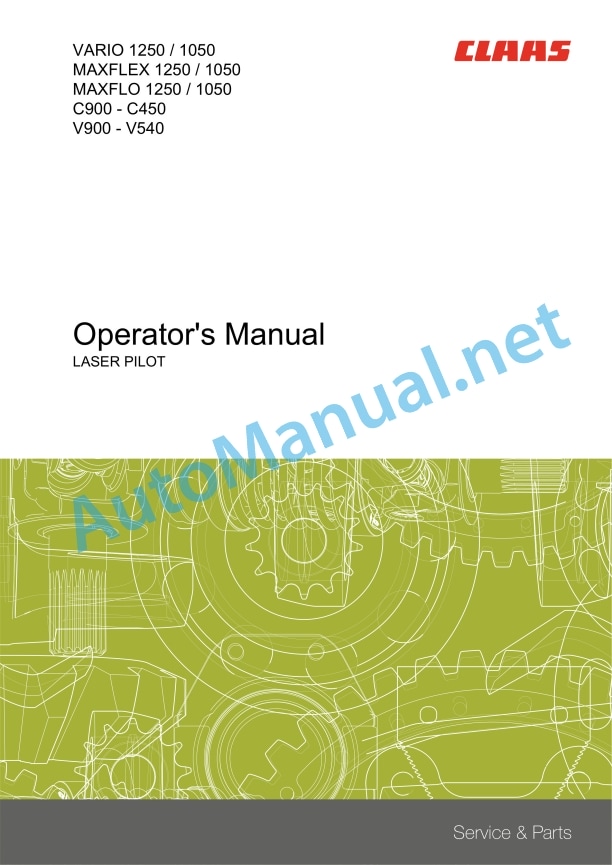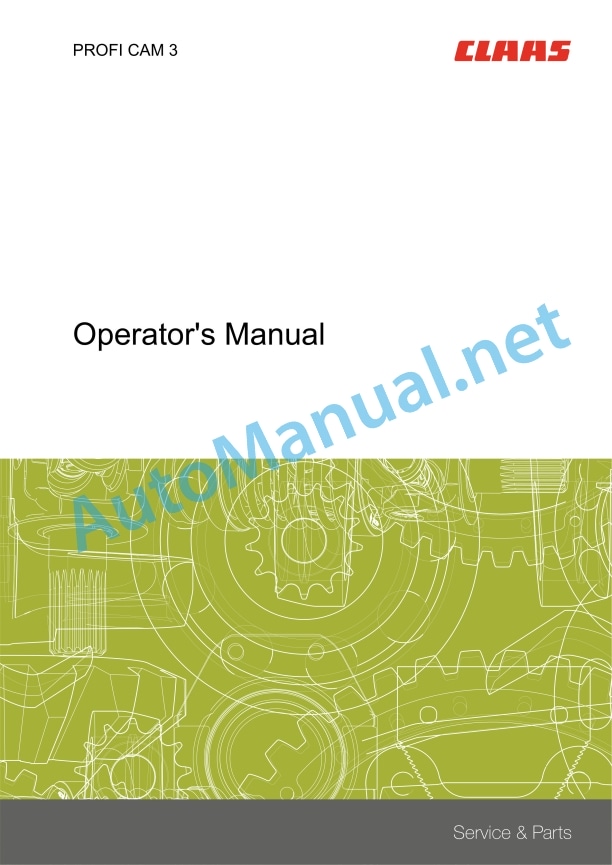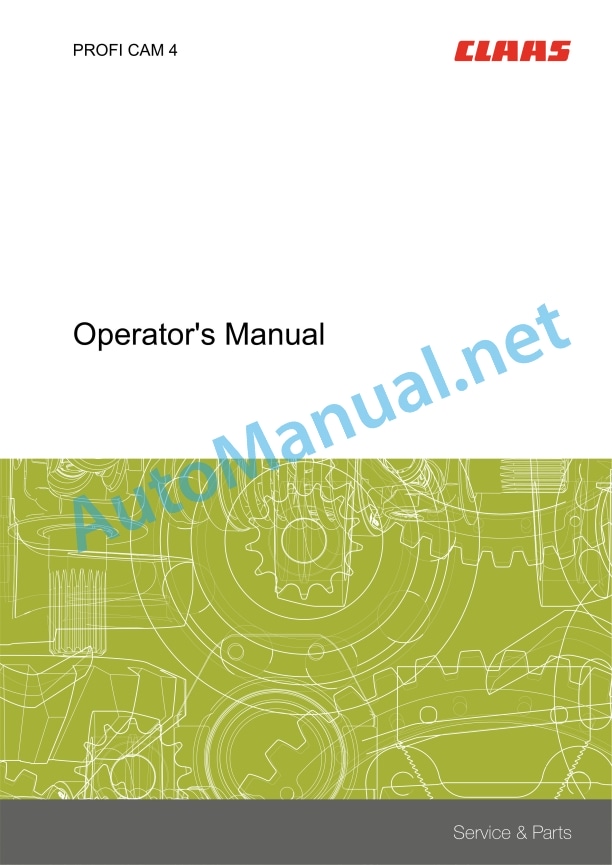Claas Maxflo 1200 (538) Combines Operator Manual EN
$50.00
- Model: Maxflo 1200 (538) Combines
- Type Of Manual: Operator Manual
- Language: EN
- Format: PDF(s)
- Size: 26.7 MB
File List:
00 0291 170 2.pdf
00 0297 292 1.pdf
00 0301 051 0.pdf
00 0303 482 0.pdf
00 0291 170 2.pdf:
MAXFLO 1200
MAXFLO 1050
MAXFLO 900
Table of contents
1 To this operator’s manual
1.1 Notes on the manual
1.1.1 General instructions
1.1.2 Validity of manual
1.1.3 Symbols and notes
1.1.4 Machine equipment
1.1.5 Specifications
2 Safety
2.1 Safety Instructions for use
2.1.1 Of special importance
2.1.2 General safety and accident prevention regulations
2.1.3 Intended use
2.1.4 Sensibly foreseeable misuse
2.1.5 Precautionary measures
2.1.6 Compressed air and water
2.1.7 Danger of injury from hydraulic liquid
2.1.8 Burn prevention
2.1.9 Oils
2.1.10 Fire prevention and explosion prevention
2.1.11 Lines, tubes and hoses
2.1.12 Before every start-up
2.1.13 Putting the machine into operation
2.1.14 Road travel
2.1.15 Parking
2.1.16 First aid measures
2.1.17 Loading and lashing down the front attachment
2.1.18 Spare parts and technical questions
2.2 Safety decals on the machine
2.2.1 Safety decals
2.2.2 Position of safety decals
3 Machine description
3.1 Overview and method of operation
3.1.1 Overview of MAXFLO
3.1.2 Function
3.2 Identification plates and identification number
3.2.1 Position of identification plate
3.2.2 Front attachment identification plate explanation
3.3 Information on the machine
3.3.1 Decal
4 Operating and control elements
4.1 Hydraulic system
4.1.1 Display elements
5 Technical specifications
5.1 MAXFLO
5.1.1 Dimensions
5.1.2 Weights
5.1.3 Crop pick-up
5.1.4 Intake
5.1.5 Safety features
5.1.6 Lubricants
5.1.7 Hydraulic oil
6 Machine preparation
6.1 Shutting down and securing the machine
6.1.1 Stop and secure the machine
6.1.2 Fitting the reel safety lock
6.1.3 Setting out the reel safety locks
6.1.4 Fitting the finger bar safety device
6.2 Prior to operation
6.2.1 Carry out prior to initial commissioning
6.2.2 Carry out prior to every operation
6.3 Mounting front attachment
6.3.1 Installing the front attachment
6.3.2 Selecting a machine
6.3.3 Adapting the feed rake conveyor to the front attachment
Adapt the machine with CONTOUR ground guidance
Adapt the machine with AUTO CONTOUR ground guidance
Adapting the guide plates
6.3.4 Identifying the hydraulic oil
6.3.5 Suspending the front attachment
6.3.6 Locking the front attachment
6.3.7 Installing the universal drive shaft
6.3.8 Mounting the multi-coupler
6.3.9 Setting out the stabiliser wheels
6.4 Removing front attachment
6.4.1 Removing the front attachment
6.4.2 Removing the multi-coupler
6.4.3 Removing the universal drive shaft
6.4.4 Unlocking the front attachment
6.4.5 Unhitching front attachment
6.4.6 Raising the stabiliser wheels
6.5 Hydraulic system
6.5.1 Filling the stabiliser wheel hydraulic system
6.6 Steering
6.6.1 Installing the LASER PILOT*
6.7 Crop feeding
6.7.1 Remove the reel transport safety equipment
6.7.2 Fitting the crop divider bar
6.7.3 Converting the front attachment to swath discharge
6.7.4 Converting the front attachment to threshing
7 Operation
7.1 Safety precautions for operation
7.1.1 Avoiding collisions with the cab roof
7.2 Fieldwork
7.2.1 Prior to fieldwork
7.2.2 Checking the crop pick-up
7.3 Steering
7.3.1 Folding out the LASER PILOT (accessory)
7.4 Crop feeding
7.4.1 Adjusting the reel tines
7.5 Feeder unit
7.5.1 Adjusting the position of the intake auger
7.5.2 Adjusting the intake auger fingers
7.5.3 Adjusting the intake auger speed
7.5.4 Reversing the front attachment
Reversing the MAXFLO conveyor belt
7.5.5 Adjusting the front attachment belt conveyor speed
7.6 Mower unit
7.6.1 Installing the crop lifters (accessory)
7.6.2 Removing the crop lifters (accessory)
7.6.3 Adjusting the skids
8 Faults and remedies
8.1 Causes and remedies
8.1.1 Crop is not picked up
8.1.2 The front attachment is not parallel to the ground
8.1.3 Uneven material flow from the front attachment
8.1.4 Poor crop feeding or wrapping
8.1.5 The intake auger stops
8.1.6 Cutting height problems
8.1.7 Cutting problems
8.1.8 Knife is stopping
8.1.9 Material is wrapping around the reel
8.1.10 Reel fingers are touching the finger bar
8.1.11 The reel is not parallel to the finger bar
8.1.12 Reel stops
8.1.13 Reel does not rotate
8.2 Drives
8.2.1 Replacing the knife drive overload protection
8.3 Hydraulic system
8.3.1 Venting the reel hydraulic cylinders
8.4 Electrical / Electronic equipment
8.4.1 Adjusting the cutting height potentiometer
8.4.2 Adjusting the reel speed sensor
8.5 Crop feeding
8.5.1 Adjusting the reel height
8.5.2 Replacing the reel tines
8.6 Feeder unit
8.6.1 Replacing intake auger fingers
8.6.2 Changing the belt
9 Maintenance
9.1 General maintenance Information
9.1.1 Fixing material
9.1.2 After the harvest
9.2 Maintenance schedules
9.2.1 Handling of maintenance intervals
9.2.2 Before the harvest
9.2.3 After the first 50 operating hours
9.2.4 Every 50 operating hours
9.2.5 After the first 100 operating hours
9.2.6 Every 100 operating hours
9.2.7 Every 250 operating hours
9.2.8 Every 500 operating hours or annually
9.2.9 After the harvest
9.3 Gearbox / Clutch / Universal drive shaft
9.3.1 Overview of gearbox
9.3.2 Changing the angle drive (G1) oil
Draining the angle drive (G1) oil
Topping up the angle drive (G1) oil
Checking the oil level of the angle drive (G1)
9.3.3 Changing the cylindrical angular gear (G2) oil
Draining oil from the cylindrical angular gear (G2)
Topping up oil in the cylindrical angular gear (G2)
Checking the oil level of the cylindrical angular gear
9.3.4 Changing the angle drive (G3) oil
Draining the angle drive (G3) oil
Topping up the angle drive (G3) oil
Checking the oil level of the angle drive (G3)
9.3.5 Changing the spur gearbox (G4) oil
Draining the spur gearbox (G4) oil
Topping up the spur gearbox (G4) oil
Checking the oil level of the spur gearbox (G4)
9.4 Drives
9.4.1 Adjusting the reel drive chain
9.4.2 Checking the chain tension
9.5 Hydraulic system
9.5.1 Changing the hydraulic tank oil
Draining oil from the hydraulic tank
Topping up oil in the hydraulic tank
Checking the oil level in the hydraulic tank
9.5.2 Changing the return flow filter on the hydraulic tank
9.6 Feeder unit
9.6.1 Adjusting the belt tension
9.7 Mower unit
9.7.1 Changing the knives
9.7.2 Adjusting the knife clips
9.7.3 Changing the knife segment
9.7.4 Aligning the double fingers
9.8 Lubrication chart
9.8.1 Grease points – 50 h
9.8.2 Lubrication points – 100 h
10 Placing out of operation and disposal
10.1 General Information
10.1.1 Removal from service and disposal
11 Technical terms and shortcuts
11.1 Terms and explanations
11.1.1 Technical terms
11.1.2 Abbreviations
12 EC-declaration of conformity
12.1 MAXFLO
12.1.1 EC Declaration of Conformity
00 0297 292 1.pdf:
VARIO 1250 / 1050MAXFLEX 1250 / 1050MAXFLO 1250 / 1050C900 – C450V900 – V540
Table of contents
1 Introduction
1.1 Notes on the manual
1.1.1 Validity of manual
1.1.2 Notes on the Operator’s Manual
2 Safety
2.1 Identifying warnings
2.1.1 Hazard signs
2.1.2 Signal word
2.2 Safety rules
2.2.1 Operator’s Manual and other sources of information
Meaning of Operator’s Manual
2.2.2 Invisible laser radiation of laser class 1M
2.2.3 Intended use
3 Technical specifications
3.1 LASER PILOT
3.1.1 LASER PILOT
4 Operation
4.1 Steering
4.1.1 Folding out the LASER PILOT
4.1.2 Adjusting the LASER PILOT
Preparing the field
Adjusting the LASER PILOT to the crop
Adjusting the LASER PILOT to the crop
Preparing the adjusting procedure
Checking the LASER PILOT setting
Adjusting the LASER PILOT vertically
Checking the horizontal LASER PILOT pre-setting
Fine-adjusting the LASER PILOT horizontally
5 Faults and remedies
5.1 Overview of faults
5.1.1 LASER PILOT
00 0301 051 0.pdf:
PROFI CAM 3
Table of contents
1 Introduction
1.1 Notes on the manual
1.1.1 Validity of manual
1.1.2 Information about this Operator’s Manual
1.1.3 Symbols and notes
1.1.4 Optional equipment
1.1.5 Qualified specialist workshop
1.1.6 Maintenance information
1.1.7 Warranty notes
1.1.8 Spare parts and technical questions
1.2 Intended use
1.2.1 Intended use
1.2.2 Reasonably foreseeable misuse
2 Safety
2.1 Identifying warnings
2.1.1 Hazard signs
2.1.2 Signal word
2.2 Safety rules
2.2.1 Meaning of Operator’s Manual
2.2.2 Observing safety decals and warnings
2.2.3 Optional equipment and spare parts
3 Product description
3.1 Overview and method of operation
3.1.1 How the PROFI CAM works
3.2 Identification plates and identification number
3.2.1 Position of identification plates
3.2.2 Explanation of PROFI CAM identification plate
3.3 Information on the product
3.3.1 CE marking
4 Operating and control elements
4.1 Camera system
4.1.1 Camera system monitor
4.2 Menu structure
4.2.1 Main menu
4.2.2
4.2.3
4.2.4
4.2.5
4.2.6
5 Technical specifications
5.1 PROFI CAM
5.1.1 Monitor
5.1.2 Camera
5.1.3 Switch box
5.1.4 Degree of protection against foreign bodies and water
6 Preparing the product
6.1 Shutting down and securing the machine
6.1.1 Switching off and securing the machine
6.2 Prior to operation
6.2.1 Carry out prior to operation
6.2.2 Installing the sun protection
6.2.3 Aligning the camera
6.2.4 Connecting the camera electrics
7 Operation
7.1 Monitor
7.1.1 Switching on the monitor
7.1.2 Calling up the menu
7.1.3 Setting a menu item
7.1.4 Setting the image orientation
7.1.5 Setting automatic screen darkening
7.1.6 Image mirroring
7.1.7 Setting the trigger view
7.1.8 Setting the follow-up time for trigger view
7.1.9 Setting the display mode
7.1.10 Activating/deactivating a display mode
8 Faults and remedies
8.1 Electrical and electronic system
8.1.1 Overview of problems on PROFI CAM camera system
8.1.2 Replacing the switch box fuse
9 Maintenance
9.1 Maintenance intervals
9.1.1 Every 10 operating hours or daily
9.2 Camera system
9.2.1 Checking the camera system for dirt
9.2.2 Cleaning the camera
9.2.3 Cleaning the switch box
9.2.4 Cleaning the monitor
10 Placing out of operation and disposal
10.1 General Information
10.1.1 Putting out of operation and disposal
11 Technical terms and abbreviations
11.1 Abbreviations
11.1.1 Units
11.1.2 Abbreviations
11.1.3 Technical terms
00 0303 482 0.pdf:
PROFI CAM 4
Table of contents
1 Introduction
1.1 Notes on the manual
1.1.1 Validity of manual
1.1.2 Information about this Operator’s Manual
1.1.3 Symbols and notes
1.1.4 Optional equipment
1.1.5 Qualified specialist workshop
1.1.6 Maintenance information
1.1.7 Notes on warranty
1.1.8 Spare parts and technical questions
1.2 Intended use
1.2.1 Intended use
1.2.2 Reasonably foreseeable misuse
2 Safety
2.1 Identifying warnings
2.1.1 Hazard signs
2.1.2 Signal word
2.2 Safety rules
2.2.1 Meaning of Operator’s Manual
2.2.2 Structural changes
2.2.3 Optional equipment and spare parts
2.2.4 Operation only following proper putting into operation
2.2.5 Technical status
2.2.6 Respecting technical limit values
Respecting technical limit values
2.2.7 Hazards when driving on roads and fields
3 Product description
3.1 Overview and method of operation
3.1.1 How the PROFI CAM works
3.2 Identification plates and identification number
3.2.1 Identification plates
3.3 Information on the product
3.3.1 CE marking
4 Operating and display elements
4.1 Camera system
4.1.1 Camera system monitor
4.1.2 CEBIS
4.2 Menu structure
4.2.1 Main menu
4.2.2
4.2.3
4.2.4
4.2.5
4.2.6
5 Technical specifications
5.1 PROFI CAM
5.1.1 Monitor
5.1.2 Camera
5.1.3 Switch box
6 Preparing the product
6.1 Switching off and securing the machine
6.1.1 Switching off and securing the machine
6.2 Prior to putting into operation
6.2.1 Carry out prior to operation
6.2.2 Installing the sun protection
6.2.3 Aligning the camera
7 Operation
7.1 Monitor
7.1.1 Switching on the monitor
7.1.2 Calling up the menu
7.1.3 Setting a menu item
7.1.4 Setting the image orientation
7.1.5 Setting automatic screen darkening
7.1.6 Image mirroring
7.1.7 Setting the trigger view
7.1.8 Setting the follow-up time for trigger view
7.1.9 Setting the display mode
7.1.10 Activating/deactivating a display mode
8 Faults and remedies
8.1 Electric and electronic system
8.1.1 Overview of problems on PROFI CAM camera system
9 Maintenance
9.1 Maintenance intervals
9.1.1 Every 10 operating hours or daily
9.2 Camera system
9.2.1 Checking the camera system for dirt
9.2.2 Cleaning the camera
9.2.3 Cleaning the switch box
9.2.4 Cleaning the monitor
10 Putting out of operation and disposal
10.1 General information
10.1.1 Putting out of operation and disposal
11 Technical terms and abbreviations
11.1 Abbreviations
11.1.1 Units
11.1.2 Abbreviations
11.1.3 Technical terms
John Deere Repair Technical Manual PDF
John Deere Repair Technical Manual PDF
John Deere Repair Technical Manual PDF
John Deere Parts Catalog PDF
John Deere Harvesters 8500 and 8700 Parts Catalog CPCQ24910 Spanish
John Deere Repair Technical Manual PDF
John Deere Repair Technical Manual PDF
John Deere Repair Technical Manual PDF
John Deere Repair Technical Manual PDF
John Deere PowerTech M 10.5 L and 12.5 L Diesel Engines COMPONENT TECHNICAL MANUAL CTM100 10MAY11
John Deere Repair Technical Manual PDF

























